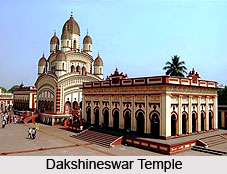 Ramakrishna, with his elder bother Ramkumar, was employed as a priest of Dakshineswar temple which was built by Rani Rasmani, a rich woman of untouchable kaivarta community of Calcutta. Ramakrishna and his nephew Hriday was employed as the assistants to Ramkumar to serve the Goddess at the temple. Being a soul of spiritual consciousness, Ramakrishna was often tormented by the question of the existence of the Goddess Kali. His soul was in want of the sight of goddess Kali and was getting impatient to quench the thirst by her revelation. Finally one day, when he was in a mood to end his life for not having the sight of mother Kali, he saw a ray of wave was coming out of the deity and seeing that Ramakrishna lost his consciousness. From then onwards the sight of Mother Kali became a normal experience to Ramakrishna. These incidents of Ramakrishna spread near and far, which resulted in visiting a huge crowd everyday to Ramakrishna and listen to his experience of "Matri Darshan". The room where Ramakrishna lived became a place of gathering of his disciples and people of all religions, communities and different educational background.
Ramakrishna, with his elder bother Ramkumar, was employed as a priest of Dakshineswar temple which was built by Rani Rasmani, a rich woman of untouchable kaivarta community of Calcutta. Ramakrishna and his nephew Hriday was employed as the assistants to Ramkumar to serve the Goddess at the temple. Being a soul of spiritual consciousness, Ramakrishna was often tormented by the question of the existence of the Goddess Kali. His soul was in want of the sight of goddess Kali and was getting impatient to quench the thirst by her revelation. Finally one day, when he was in a mood to end his life for not having the sight of mother Kali, he saw a ray of wave was coming out of the deity and seeing that Ramakrishna lost his consciousness. From then onwards the sight of Mother Kali became a normal experience to Ramakrishna. These incidents of Ramakrishna spread near and far, which resulted in visiting a huge crowd everyday to Ramakrishna and listen to his experience of "Matri Darshan". The room where Ramakrishna lived became a place of gathering of his disciples and people of all religions, communities and different educational background.
For Ramakrishna, Dakshineswar was the place where his spiritual sadhana got intensity and consistency. He devoted his soul to the meditation and after his priestly duties he would spend meditating in the Panchavati groove in Dakshineswar. He would fill with great ecstasy and tears rolled down from his eyes, he would get unaware of the materialistic world and reached the realm of divinity.
Performing as a priest of Dakshineswar temple, Ramakrishna felt identicalness with goddess Kali. The way Ramakrishna worshipped goddess Kali was beyond the rituals according to some other priests and inhabitants of the vicinity. They became inquisitive about the intention of Ramakrishna and some blamed him as an unorthodox worshipper of God and the off track person of Brahmin community.
Ramakrishna, through his preaching to the gathering always emphasized on the realization of soul and the complete devotion to God. Ramakrishna`s religious preaching would get its effectiveness because of his simple explanation through parables and stories in rustic Bengali. At the time of his spiritual transformation, Ramakrishna was often accused of acting eccentric and some of the people close to him considered it as a state of lunacy. This lunatic behavior of Ramakrishna was described as "spiritual madness" by an elderly holy woman. A group of spiritual practitioners examined the symptoms of Ramakrishna and finally opined that his madness resembled the similar to the state of Chaitanya(a fifteenth century Bengali saint). People started treating Ramakrishna with respect thereafter. The holy woman, Bhairavi Brahmani who discovered the "spiritual madness" in Ramakrishna remained a teacher of Ramakrishna for sometime and taught him the techniques of yogic and tantric meditation.
In Kamarpukur, people started believing in the rumor that Ramakrishna had reached to a state of insanity due to his excessive involvement in spiritual practices. Thinking marriage as the best remedy for Ramakrishna, his mother and elder brother Rameshwara decided to get Ramakrishna marriage. They thought that the mundane responsibilities could bring him to the normal state and deviate his soul from the obsession of spiritual practices. Ramakrishna at his early twenties was knotted with Sarada Devi who was five years old, residing in Jayrambati. After marriage, Sarada Devi happened to be the first disciple of Ramakrishna. Sarada Devi was attracted towards the spiritual devotion of Ramakrishna and dedicated herself in learning all the religious secrets what Ramakrishna had to teach. Ramakrishna, finding the devotional soul which thrived for spirituality and mastered the ways to achieve God, started considering her as the Universal Mother and performed a puja considering Sarada Devi as veritable Tripura Sundari Devi.
Ramakrishna said to her, "I look upon you as my own mother and the Mother who is in the temple".
At the age of twenty eight, Ramakrishna started studying various traditional religious scriptures and gained knowledge about different religions and their sayings. Ultimately he established that every religion is the same, they say the oneness of the God. He said, "Creeds and sects matter nothing. Let every one perform with faith the devotions and practices of his creed. Faith is the only clue to get to God". Ramakrishna had a vision of a "radiant figure" of the founder of Islam Mohammed, which coagulated his spiritual practice.




















